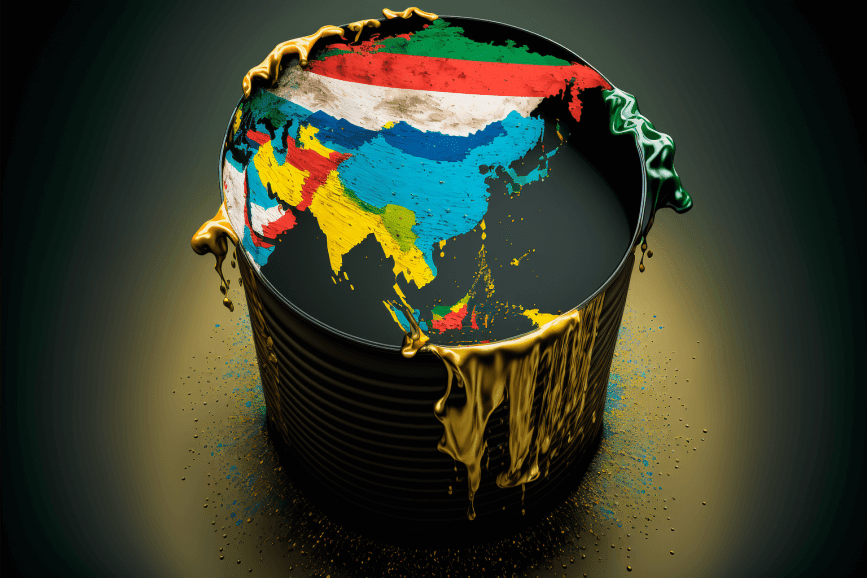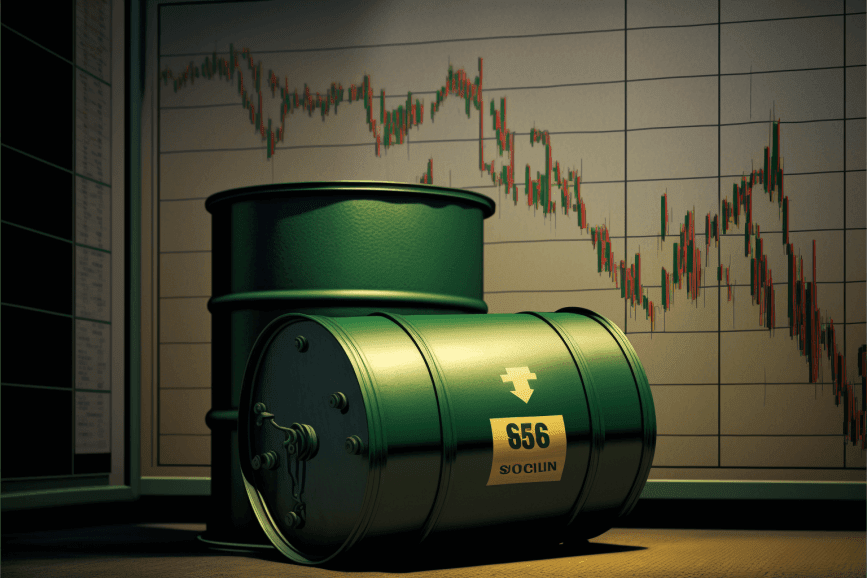Crude Oil Market Outlook: Understanding the Dynamics of a Global Industry
An overview of how the crude oil market is influenced by economic conditions, geopolitical events, technological developments, and environmental concerns.

I. Introduction
The crude oil market is one of the most important and dynamic industries in the world. It plays a crucial role in powering economies and shaping global politics. Understanding the market dynamics is essential for businesses, investors, policymakers, and consumers alike. This article aims to provide a comprehensive overview of the crude oil market and its key elements.
Crude oil, also known as petroleum, is a fossil fuel that is extracted from the ground. It is a mixture of hydrocarbons, primarily composed of alkanes and cycloalkanes, and can be refined into various products such as gasoline, diesel, and jet fuel. There are different types of crude oil, each with distinct characteristics and uses.
Production and consumption of crude oil are global phenomena. The top crude oil-producing countries are the United States, Russia, and Saudi Arabia, while the largest consumers are China, the United States, and India. The crude oil market is influenced by various key players, including national oil companies, international oil companies, and state-owned enterprises.
Despite the ongoing efforts to transition to renewable energy sources, crude oil remains a vital source of energy and is projected to continue to be so in the foreseeable future. The market size and growth are influenced by a variety of factors, including economic conditions, geopolitical events, technological developments, and environmental concerns. In this article, we will explore these factors in more detail and provide a comprehensive outlook for the crude oil market.
II. Market Overview

The crude oil market is a global industry that plays a major role in the world's economy. Crude oil is a vital resource that is used to produce a wide range of products, including gasoline, diesel, and jet fuel, as well as petrochemical products such as plastics, fertilizers, and pesticides.
The crude oil market is dominated by a small number of major players, including state-owned national oil companies, international oil companies, and independent oil and gas companies. These companies are involved in a range of activities, including exploration, production, refining, and marketing of crude oil and its derivatives.
The crude oil market is highly susceptible to fluctuations in supply and demand, as well as geopolitical tensions and economic conditions. The prices of crude oil are determined by a number of factors, including global supply and demand, economic conditions, and geopolitical events.
Over the past decade, the crude oil market has been affected by a number of key trends, including the increasing use of natural gas as a source of energy, the shift towards cleaner and more sustainable forms of energy, and the growing use of technology in the exploration, production, and refining of crude oil. Additionally, the ongoing geopolitical tensions, such as the U.S sanctions on Iran, Russia and Venezuela, also have an impact on the market.
It is important for market players to stay informed of these trends and the factors that influence the crude oil market in order to make informed decisions and stay competitive in the industry. The market is constantly evolving, and companies must be prepared to adapt their strategies accordingly in order to succeed.
III. Factors Influencing the Market

The crude oil market is a complex and dynamic industry that is influenced by a variety of factors. These factors can have a significant impact on the market, affecting the price of crude oil and shaping the way the industry operates. In this section, we'll take a closer look at some of the key factors that are influencing the crude oil market, including economic conditions, geopolitical events, technological developments, and environmental concerns.
Economic conditions are one of the most significant factors influencing the crude oil market. The demand for crude oil is closely tied to the overall health of the global economy. When the global economy or a particular country specific economy is doing well, the demand for crude oil typically increases, which can drive up the price of oil. On the other hand, when a economy is struggling, the demand for crude oil may decrease, which can lead to a decrease in the price of oil.
When the economy is growing, the demand for crude oil typically increases, as businesses and consumers have more disposable income to spend on energy. This can lead to higher prices for crude oil, as the increased demand puts upward pressure on prices. Additionally, when the economy is in a upward swing, the demand for industrial goods and transportation increases, which in turn increases the demand for crude oil.
On the other hand, when the economy is struggling, the demand for crude oil may decrease. Consumers and businesses have less disposable income to spend on energy, and the demand for industrial goods and transportation also decreases. This can lead to a decrease in the price of oil, as the decrease in demand puts downward pressure on prices.
The relationship between crude oil prices and economic conditions is not always straightforward, however, as many other factors can also influence the market. Oil prices can be affected by political and geopolitical events, technology advancements, and environmental concerns. Furthermore, the relationship between economic conditions and oil prices can also be influenced by government policies and regulations, such as taxes and subsidies, and by the actions of major players in the market, such as national oil companies, international oil companies, and state-owned enterprises.
It's important to note that the crude oil market is closely tied to the foreign exchange market, as oil prices are often quoted in US dollars. Therefore, changes in the value of the dollar against other currencies will affect the crude oil market. When the value of the dollar decreases, it can cause crude oil price to be more expensive for countries that use other currencies, which can decrease the demand for oil and decrease prices. Conversely, when the value of the dollar increases, it can make crude oil less expensive for countries that use other currencies, which can increase the demand for oil and increase prices.
Geopolitical events have a major impact on the crude oil market. Conflicts, political instability, and changes in government can all affect the supply and demand for crude oil, influencing the price of oil. For example, if a major oil-producing country is experiencing political instability, it can lead to a disruption in the supply of oil, which can drive up the price of oil.
Technological developments are also playing an increasingly important role in the crude oil market. Advances in technology are making it easier and more cost-effective to extract oil from unconventional sources, such as shale oil. This has led to a significant increase in the supply of oil, which has had a downward effect on the price of oil. Additionally, technological advancements in the refining process are also allowing for the production of new, high-value products, further changing the crude oil market.
Environmental concerns are also a key factor influencing the crude oil market. Increasing awareness of the environmental impact of crude oil production and consumption has led to efforts to transition to renewable energy sources, which can decrease demand for crude oil. Additionally, government regulations and policies aimed at reducing carbon emissions can also have an impact on the crude oil market.
In conclusion, the crude oil market is a complex and dynamic industry that is influenced by a variety of factors. Understanding these factors is essential for businesses, investors, policymakers, and consumers alike, as they can have a significant impact on the market. In this section, we have explored some of the key factors influencing the crude oil market, including economic conditions, geopolitical events, technological developments, and environmental concerns.
IV. Market Trends

The crude oil market is constantly evolving, and understanding current and emerging trends is essential for businesses, investors, policymakers, and consumers alike. In this section, we'll take a closer look at some of the key trends shaping the crude oil market today.
A trend that has been gaining momentum in recent years is the shift towards cleaner and more sustainable forms of energy. With increasing concerns about the environmental impact of crude oil production and consumption, there has been a growing push to transition to renewable energy sources such as solar, wind, and hydroelectric power. This trend is expected to continue in the future, which could lead to a decrease in demand for crude oil and lower prices.
Another trend that is influencing the crude oil market is the increasing use of electric vehicles (EVs). With the growing adoption of EVs, the demand for gasoline and diesel is expected to decrease, which could lead to a decrease in demand for crude oil.
A third trend that is shaping the crude oil market is the growing use of natural gas as a source of energy. Natural gas is a cleaner and more efficient source of energy compared to crude oil, and its use is expected to continue to grow in the future. This trend could lead to a decrease in demand for crude oil, as well as lower prices.
A fourth trend that is affecting the crude oil market is the increasing use of technology in the exploration, production, and refining of crude oil. Advances in technology are making it easier and more cost-effective to extract oil from unconventional sources, such as shale oil, and to refine crude oil into high-value products. This trend is expected to continue in the future, which could lead to an increase in the supply of oil and lower prices.
In conclusion, the crude oil market is constantly evolving and understanding current and emerging trends is essential for businesses, investors, policymakers, and consumers alike. In this section, we've looked at some of the key trends shaping the crude oil market today, including the shift towards cleaner and more sustainable forms of energy, the increasing use of electric vehicles, the growing use of natural gas.
V. Market Forecast

In this section, we'll take a closer look at some of the key factors that are expected to shape the crude oil market in the future, and provide a forecast of what we can expect in terms of prices and demand.
A key aspect that is expected to influence the crude oil market in the future is the ongoing transition towards cleaner and more sustainable forms of energy. As discussed earlier, there is a growing push to transition to renewable energy sources such as solar, wind, and hydroelectric power, which could lead to a decrease in demand for crude oil and lower prices. Additionally, the increasing use of electric vehicles, which we also discussed earlier, could also lead to a decrease in the demand for crude oil.
Another key factor that is expected to shape the crude oil market in the future is the increasing use of natural gas as a source of energy. As discussed earlier, natural gas is a cleaner and more efficient source of energy compared to crude oil, and its use is expected to continue to grow in the future. This trend could lead to a decrease in demand for crude oil, as well as lower prices.
A third key factor that is expected to shape the crude oil market in the future is the growing use of technology in the exploration, production, and refining of crude oil. As discussed earlier, advances in technology are making it easier and more cost-effective to extract oil from unconventional sources, such as shale oil, and to refine crude oil into high-value products. This trend is expected to continue in the future, which could lead to an increase in the supply of oil and lower prices.
A fourth key factor that is expected to shape the crude oil market in the future is the ongoing geopolitical tensions. Political instability in key oil-producing countries, such as Venezuela, Russia and Iran, could lead to a decrease in the supply of oil and higher prices. Additionally, tensions between major oil-producing countries, such as Saudi Arabia and Russia, could also have an impact on the market.
In terms of prices, it is likely that we will see a decrease in crude oil prices in the short-term due to the ongoing transition towards cleaner and more sustainable forms of energy, as well as the increasing use of natural gas as a source of energy. Additionally, the growing use of technology in the exploration, production, and refining of crude oil is also expected to lead to an increase in the supply of oil and lower prices.
However, in the long-term, it's possible that we may see an increase in crude oil prices due to the limited availability of conventional oil sources and the rising demand for oil in developing countries. Additionally, geopolitical tensions and instability in key oil-producing countries could also lead to a decrease in the supply of oil and higher prices.
In terms of demand, it is likely that we will see a decrease in the demand for crude oil in the short-term due to the ongoing transition towards cleaner and more sustainable forms of energy, as well as the increasing use of electric vehicles. However, in the long-term, it's possible that we may see an increase in the demand for crude oil due to the rising population and economic growth in developing countries.
In conclusion, the crude oil market is expected to be shaped by a variety of factors in the future, and the prices and demand for crude oil are likely to fluctuate based on these factors. While there may be a decrease in prices and demand in the short-term due to the ongoing transition towards cleaner and more sustainable forms of energy and the increasing use of natural gas, there may be an increase in prices and demand in the long-term due to limited availability of conventional oil sources and rising population and economic growth in developing countries. Additionally, geopolitical tensions and instability in key oil-producing countries could also have an impact on the market. It is important for market players to stay informed and adapt to these changes in order to stay competitive in the crude oil market.
VI. Conclusion
In summary, the crude oil market is a complex and dynamic system that is influenced by a magnitude of factors. These include the ongoing transition towards cleaner and more sustainable forms of energy, the increasing use of natural gas as a source of energy, the growing use of technology in the exploration, production, and refining of crude oil, and the ongoing geopolitical tensions.
The prices of crude oil are likely to decrease in the short-term due to the shift towards cleaner and more sustainable forms of energy and the increasing use of natural gas. However, in the long-term, prices may increase due to the limited availability of conventional oil sources and the rising demand for oil in developing countries.
Similarly, the demand for crude oil is likely to decrease in the short-term due to the shift towards cleaner and more sustainable forms of energy and the increasing use of electric vehicles. However, in the long-term, demand may increase due to the rising population and economic growth in developing countries.
It is important for market players to stay informed and adapt to these changes in order to stay competitive in the crude oil market. The market is continuously changing, and companies must stay vigilant and be prepared to adapt their strategies accordingly in order to succeed.
In conclusion, the crude oil market is a complex and dynamic industry that is influenced by a variety of factors. It is important for market players to stay informed and adapt to these changes in order to stay competitive in the market.
